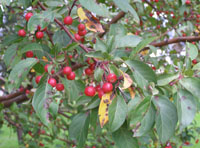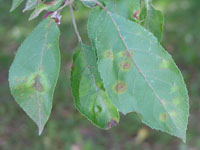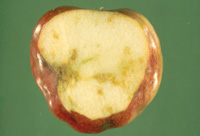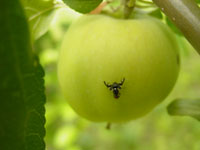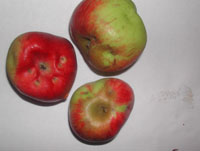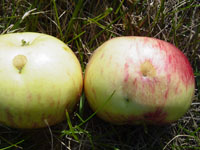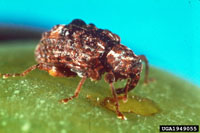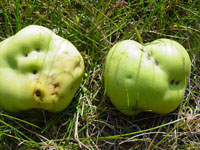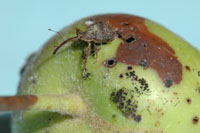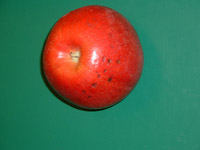Extension > Garden > Diagnose a problem > What's wrong with my plant? > Fruit > Apple > Deformed fruit
Apples > Fruit >Deformed fruit
1 of 6
Apple Scab
Venturia inaequalis
- Brown raised corky spots on fruit
- Severely infected fruit may be deformed and cracked
- Olive green to brown leaf spots with an irregular or feathered edge, eventually becoming a dark brown to black
- Infected leaves turn yellow and drop prematurely
- More information on Apple Scab
2 of 6
Apple Maggot
Rhagoletis pomonella
- Adult fly causes punctures by laying eggs under the apple skin, resulting in dimpled and misshapen fruit
- Larvae tunnel inside fruit resulting in brown streaks and decay
- Adult fly is black with clear wings and black bands, and a white spot on the back
- Larvae are legless, white, and 1/3""in length when mature (rarely seen)
- Adults are active from July until September
- More information on Apple Maggot
3 of 6
Plum Curculio
Conotrachelus nenuphar
- Adult weevils lay eggs in the apples resulting in distinctive crescent shaped tan spots on the skin
- Fruit can become misshapen and often drop prematurely
- Adult weevil is small (1/5” in length), dark brown with whitish-gray patches, bumps on the wings, and a distinctive downward-curved snout
- Mature larvae are yellow-white, ¼" long, and c-shaped (rarely seen)
- Adults active in early spring (during bloom)
- More information on Plum Curculio
4 of 6
Apple Curculio
Anthonomus quadrigibbus
- Adult weevils makes small punctures by feeding and laying eggs in the apple, resulting in a round tan spot and lumpy/misshapen fruit
- Adult weevil is reddish brown, ¼ inch long, with four bumps on their backs
- Weevils are present in early spring
5 of 6
Tarnished Plant Bug
Lygus lineolaris
- Young fruit can have pitted, deformed fruit when adults insert eggs and feed on them
- Feeding on flower buds results in loss of flowers
- Adults are oval shaped, approximately ¼ inch long, brownish in color with streaked yellow and black lines (tarnished appearance), and have a white V-shaped marking on its back
- Nymphs may be confused with aphids, however, they move fast when disturbed (aphids do not)
- Adults and nymphs are present early in the season (April-May)
- More information on Tarnished Plant Bug
6 of 6
Bitter Pit
- Fruit develops dark sunken pits and brown corky tissue within the white apple flesh around the blossom end of the fruit
- May be caused by calcium deficiency, warm weather and moisture stress during fruit maturity, harvesting too early, heavy pruning, or excessive nitrogen fertilizer application
- Reduce bitter pit with well-timed irrigation, calcium nitrate foliar sprays before harvest, controlled atmosphere storage, and postharvest waxing
- More information on Bitter pit




